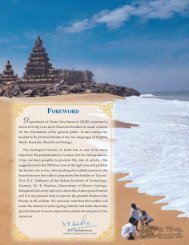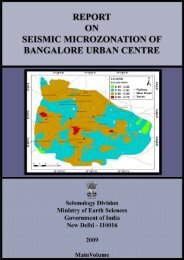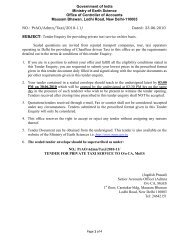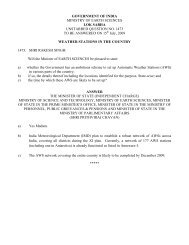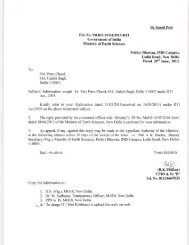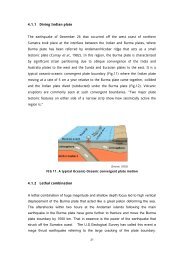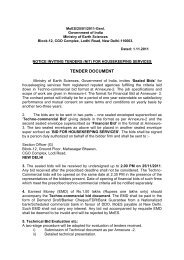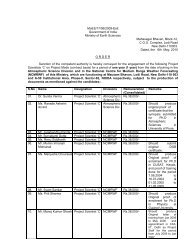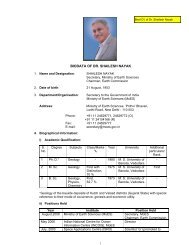Annual Report 2007-2008 - Ministry Of Earth Sciences
Annual Report 2007-2008 - Ministry Of Earth Sciences
Annual Report 2007-2008 - Ministry Of Earth Sciences
Create successful ePaper yourself
Turn your PDF publications into a flip-book with our unique Google optimized e-Paper software.
<strong>Ministry</strong> of <strong>Earth</strong> <strong>Sciences</strong>, <strong>Annual</strong> <strong>Report</strong> <strong>2007</strong>-08• Temperature and Salinity Climatology for 19 levels was developed using Argo data and it isavailable in netCDF format for publishing it on Web.• Sea Surface Temperature from Argo float data along with the moored buoy were utilised tovalidate the AMSRE and TMI SST data. Results of this study were communicated as aresearch paper on “Comparison of AMSR-E and TMI sea surface temperature with Argonear surface temperature over the Indian Ocean” for publication.• Relationship between Indian Ocean surface oceanographic parameters and Indian summermonsoon rainfall was studied using satellite derived sea surface temperature and sea surfaceheight anomaly.• Argo/Altimeter based currents were integrated with Ekman currents derived from Qscat windsfor getting total currents. Information on the available current meter data is being pooled forvalidation of the derived currents from Argo Altimeter and Qscat.• Heat content in Indian Ocean was analysed starting from 1990 to 2006. The temperature at(0 m, 100 m, 500 m, 2000 m) and heat contents (integrated up to 300 m, 500 m, 1000 m)were analysed with Sea Surface Height Anomaly. Trends and relation between temperature,heat content and SSHA are being analysed.• Float - to - float data and float - to - CTD data comparisons were carried out to check theconsistency of the Argo float data.• Heat content anomalies with respect to World Ocean Atlas 2005 in the Indian Ocean arebeing analysed for the periods1990-2006. The temperature anomaly trends at (0 m, 100 m,500 m, 2000 m) and heat content anomaly (integrated up to 300 m, 500 m, 1000 m) arebeing analysed in this study.• Diurnal to inter-annual rainfall variability over Indian Ocean is being studied.• Studied the Mixed Layer Depth (MLD) variability in the Northern Arabian Sea, based on thedaily data obtained from float (WMO 2900211) and the manuscript has been accepted forpublication in Ocean Science Journal.• Sonic Layer Depth (SLD) variability in the central Arabian Sea monthly mean SLD was obtainedfrom temperature and salinity data from 2002 to 2006 and the manuscript is under review forpublication in Ocean Science Journal.Ocean Observations• Bay of Bengal Cruise was organised to understand the upper ocean heat budget by conductingobservations with CTD, hyper-spectral radiometer and other surface met flux measurementsonboard ORV Sagar Kanya during 10-23 November, <strong>2007</strong>. Scientists from INCOIS, NIO,IISc, PMEL/NOAA, SAC and NCAOR participated in this cruise.32




